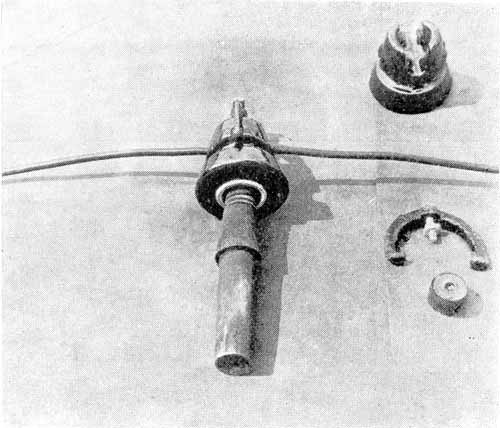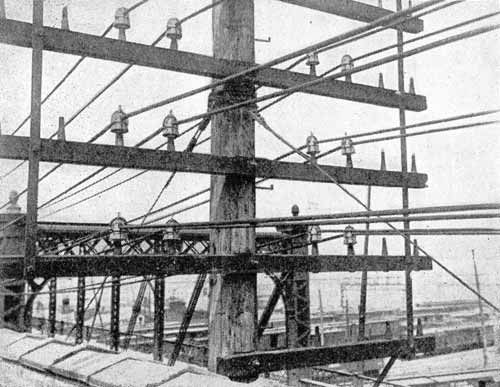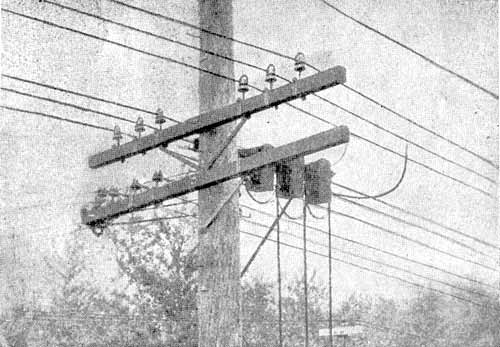[Trade Journal]
Publication: Electrical World
New York, NY, United States
vol. 60, no. 14, p. 725-726, col. 1-2
USE OF CLAMP INSULATORS WITHOUT
TIE-WIRES IN ST. LOUIS.
On the arc circuits and 4400-volt distribution lines of the Union Electric Light & Power Company, St. Louis, nearly 20,000 Fay clamp-type insulators are now in use, the first of these tie-wire-less insulators having been installed about eighteen months ago. In these insulators the tie-wire is replaced by a galvanized bale clamp, similar to those used on some fruit jars, which exerts pressure through a round porcelain pin to clamp the wire down into its slotted seat in the body of the insulator, without injury to the wire or its insulation. This construction was fully described and illustrated in the Electrical World of May 19, 1910. The insulator was devised by a former line superintendent of the St. Louis company, Mr. John L. Fay, now superintendent of distribution for The Milwaukee Electric Railway & Light Company.
| |||
| Fig. 1 - Clamp Insulator and Parts. |
The first carload of these insulators used in St. Louis was ordered to equip the city arc circuits, which had been giving much trouble from the corrosion and breaking of line wires just under the necks of the tie wires. As this peculiar action occurred only on the magnetite or direct-current circuits, the cause appears to have been electrolytic, after being started by slight nicks made in tying up the tie wires. Use of the clamp insulators has, however, completely removed the trouble, according to Mr. K. H. Hansen, electrical engineer for the company. The same construction is now being extended to 4400-volt feeder construction, as shown in the accompanying illustration. Among the advantages secured by the use of the clamp insulators are the superior quickness and permanency with which they can be installed; prevention of injury to line-wire insulation; avoidance of kinking by the linemen in making a wire tie, and elimination of corrosion of the wire at the neck of the tie - all of which lead to ultimate breaking of the wire. If such broken span drops into the street, it is highly dangerous; if the insulation holds it, the break under the tie-wire is extremely difficult to locate. The position of the wire at the top of the new clamp insulator also introduces greater insulating value for the same size, compared with the usual side-tie insulator. A lineman can also replace insulators or pins when using the clamp device, without "killing" the line, since the insulator has no holding or conducting parts in contact with the wire. In case a pin is broken, the wire can be tied up in an emergency by passing a cord or wire through the clamp arms, without impairing the insulation of the line.
Purchased in quantities the St. Louis clamp insulators cost, complete with bale and parts, 11 cents each. The equivalent No. 30 porcelain insulator of the ordinary type has recently risen in price to 5.75 cents. A No. 6 tie wire at the present price of copper costs 2 cents to 4 cents. After counting the copper lost and time taken to make the ordinary tie, compared with that for putting up a clamp insulator, there is a difference in cost apparently slightly in favor of the clamp insulation, especially when the advantages of permanence and safety of the clamp construction are considered.
| |||
| Fig. 2 - Clamp Insulators on Wooden Pins. |
For comparison ten poles were equipped with tie insulators, two primary wires being in easy reach, 28 ft. above the ground. It required one lineman thirty-five minutes to tie in the twenty insulators. The twenty tie wires, weighing 5 lb. 14 oz., cost [dollar:4.7 cents per insulator. For clip ends necessary for the grip of pliers 17 oz. was lost, representing a cost of [dollar: 0.875 cent per insulator. With the insulators themselves costing [dollar:5.75 cents, the total cost of material used was thus [dollar:11-1/2 cents per insulator, excluding the labor of the lineman, which at [dollar:50 cents an hour would be about [dollar:2 cents per tie. The present cost of the bale-clamp insulators is [dollar:11 cents each, complete with galvanized bale and screw, thus showing a saving of a fraction of a cent over the bare material cost of the ordinary tied construction. Since the clamp insulators permit more rapid installation, the labor cost of [dollar:2 cents per insulator would be decreased, adding to the slight advantage in price in favor of the clamp devices. But the important factor in the St. Louis situation resulting from the use of these insulators has been the permanency and freedom from broken wires and the saving of future repairs and reconstruction work. Mr. Frederick Worthington is general foreman in charge of overhead wires for the Union Electric Company.
| |||
| Fig. 3 - 4400-Volt Feeders Carried on Clamp Insulators and Clamp Pins. |



